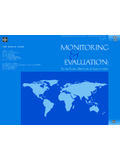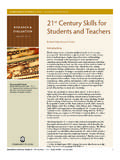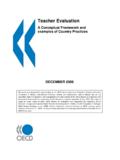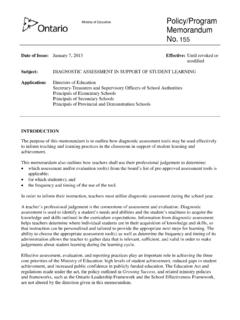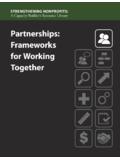Transcription of THE GREEN BOOK - Food and Agriculture Organization
1 THE GREEN BOOKA ppraisal and Evaluation in Central GovernmentTreasury GuidanceLONDON:TSOTHE GREEN BOOKivCONTENTSPageContentsivPrefacevChap ter 1 Introduction and background1 Introduction1 When to use the GREEN Book2 Chapter 2 Overview of appraisal and evaluation3 Introduction3 The appraisal and evaluation cycle3 The role of appraisal3 Process for appraisal and evaluation4 Presenting the results6 Managing appraisals and evaluations7 Frameworks8 Issues relevant to appraisal and evaluation9 Chapter 3 Justifying action11 Introduction11 Reasons for government intervention11 Carrying out research11 Chapter 4 Setting objectives13 Introduction13 Objectives, outcomes, outputs and targets13 Chapter 5 Appraising the options17 Introduction17 Creating options17 Valuing the costs and benefits of options19 Adjustments to values of costs and benefits24 Discounting26 Adjusting for differences in tax between options28 Introduction to risk and uncertainty28 Adjusting for bias and risks29 Assessing uncertainty32 Preventing and mitigating risks and uncertainty34 Considering unvalued costs and benefits34 Chapter 6 Developing and implementing thesolution37 Introduction37 Selecting the best option37 Developing the solution40 Implementation42 Chapter 7 Evaluation45 Introduction45 Evaluation process45 PageAnnex 1 Government intervention51 Introduction51 Economic efficiency51 Equity52 Additionality52 Regeneration54 Annex 2
2 Valuing non-market impacts57 Introduction57 Valuing non-market impacts57 Current research/plausible estimates59 Valuing environmental impacts63 Annex 3 Land and buildings69 Introduction69 Acquisition and use of property69 Leases and rents71 Disposal of property72 Cost effective land use72 Annex 4 Risk and uncertainty79 Introduction79 Risk management79 Transferring risk82 Optimism bias85 Monte Carlo analysis87 Irreversible risk88 The cost of variability in outcomes88 Annex 5 Distributional impacts91 Introduction91 Distributional analysis91 Analysis of impacts according to relative prosperity91 Analysis of other distributional impacts94 Annex 6 Discount rate97 Introduction97 Social Time Preference Rate97 Long term discount rates98 Exceptions to the discount rate schedule99 Discount rate tables100 Glossary101 Bibliography107 Index109 The Government is committed to continuing improvement in the delivery of public services.
3 A major part ofthis is ensuring that public funds are spent on activities that provide the greatest benefits to society, and thatthey are spent in the most efficient Treasury has, for many years, provided guidance to other public sector bodies on how proposals should beappraised, before significant funds are committed and how past and present activities should be newedition incorporates revised guidance, to encourage a more thorough, long-term and analytically robust approach toappraisal and evaluation. It is relevant to all appraisals and , done properly, is not rocket science, but it is crucially important and needs to be carried out taken at the appraisal stage affect the whole lifecycle of new policies, programmes and projects.
4 Similarly,the proper evaluation of previous initiatives is essential in avoiding past mistakes and to enable us to learn fromexperience. The GREEN book therefore constitutes binding guidance for departments and executive edition of the GREEN book is the first which has been preceded and helped by a consultationprocess has proved invaluable in shaping the final guidance. While the results have shown widespread support forthe main changes proposed, the consultation has particularly helped in making the guidance clearer and more closelytailored to users the main changes are the following. First, there is a stronger emphasis on the identification, managementand realisation of benefits in short, focusing on the end in sight, right from the beginning.
5 Secondly, the new edition unbundles the discount rate, introducing a rate of in real terms, based on social time preference, while takingaccount of the other factors which were in practice often implicitly bundled up in the old 6% real figure. In particular,the new GREEN book includes, for the first time, an explicit adjustment procedure to redress the systematic optimism( optimism bias ) that historically has afflicted the appraisal process. Finally, there is greater emphasis on assessing thedifferential impacts of proposals on the various groups in our society, where these are likely to be Treasury is grateful for the significant contributions to the development of this edition of the GREEN book madeby many others, working across government and elsewhere.
6 Particular gratitude is due to those who participated inthe consultation process and provided such detailed and valuable comments. We hope that the final version reflectsthe quality of these GriceChief Economist and Director, Public ServicesHM Treasury THE GREEN BOOKvPREFACETHE GREEN BOOKviINTRODUCTION new policies, programmes1and projects, whether revenue, capital or regulatory, should be subject tocomprehensive but proportionate assessment , wherever it is practicable, so as best to promote the public GREEN book presents the techniques and issues that should be considered when carrying out guidance is designed to promote efficient policy development and resource allocation acrossgovernment. It does this by informing decision-making, and by improving the alignment of departmental and agencypolicies, programmes and projects with government priorities and the expectations of the public.
7 The guidanceemphasises the need to take account of the wider social costs and benefits of proposals, and the need to ensure theproper use of public is achieved through: Identifying other possible approaches which may achieve similar results; Wherever feasible, attributing monetary values to all impacts of any proposed policy, project andprogramme; and Performing an assessment of the costs and benefits for relevant GREEN book is a best practice guide for all central departments and executive agencies, and coversprojects of all types and size. It aims to make the appraisal process throughout government more consistent more detailed analysis is required, as signposted throughout the GREEN book , reference should bemade to the technical advice contained in the annexes.
8 These annexes address the needs of specialist techniciansand economists by focusing on some of the more involved aspects of appraisal and evaluation. The annexes contain:The GREEN book describes how the economic, financial, social and environmental assessmentsof a policy, programme or project should be purpose of the GREEN book is to ensure that no policy, programme or project is adoptedwithout first having the answer to these questions: Are there better ways to achieve this objective? Are there better uses for these resources?111A programme is defined as a group of related projects2 Assessments is the general term used in the GREEN book to refer to both appraisals before decisions are made, and evaluations of decisions once made Guidance on the conduct of an advanced appraisal; and, The analytical foundations of the approach contained in the GREEN and agencies should ensure that their own manuals or guidelines are consistent with theprinciples contained here, providing supplementary guidance on their specific 1: ACTIVITIES COVERED BY THE GREEN BOOKWHEN TO USE GREEN book will be useful for : Anyone required to conduct a basic appraisal or evaluation of a policy, project or programme.
9 And, People seeking to expand their knowledge in this guidance applies:At the to any analysis used to support a government decision to adopt a new policy, or to initiate, renew,expand or re-orientate programmes or projects, which would result in measurable benefits and/ or costs to thepublic. This is the appraisalpart of the at the to retrospective analysis of a policy, programme or project at its completion, conclusion or is the evaluationpart of the ability to judge how effectively government resources have been expended is essential to their strategiclong-term management. Planning for this evaluation should be considered at the time of and programme developmentDecisions on the level and type of services or other actionsto be provided, or on the extent of or replacement capital projectsDecisions to undertake a project, its scale and location, timing,and the degree of private sector or disposal of existing assetsDecisions to sell land, or other assets, replace or relocatefacilities or operations, whether to contract out or markettest of regulationsDecisions, for example, on standards for health and safety,environment quality, sustainability, or to balance the costs andbenefits of regulatory standards and how they can procurement decisionsDecisions to purchase the delivery of services, works orgoods.
10 Usually from private sector GREEN BOOKC hapter 1: The Meaning and Context of Appraisal And Evaluation2 OVERVIEW OFAPPRAISAL chapter summarises the key stages of appraisal and evaluation. The remaining chapters discuss them inmore and evaluation often form stages of a broad policy cycle that some departments and agenciesformalise in the acronym ROAMEF (Rationale, Objectives, Appraisal, Monitoring, Evaluation and Feedback). This isshown below:BOX 2: ROAMEF CYCLETHEROLE should provide an assessment of whether a proposal is worthwhile, and clearly communicateconclusions and recommendations. The essential technique is option appraisal, whereby government intervention isvalidated, objectives are set, and options are created and reviewed, by analysing their costs and benefits.












